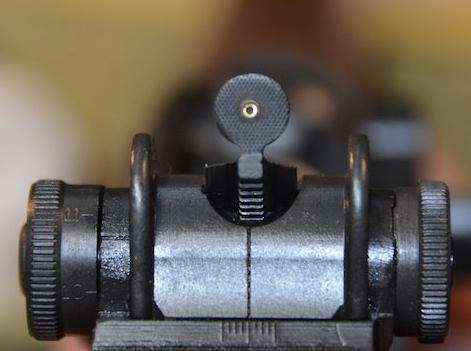This guide helps you learn how to use lasers with guns. It gives you clear steps to make sure the laser is in the right place on different types of guns. Knowing how to line up the sights and using pictures is important to make sure the laser hits the target accurately. You’ll also find out how to make small adjustments for wind and height, and fix any problems if you’ve adjusted too much. The guide also talks about things that can make the laser last longer.
Step by step guide for Sighting and Recalibrating Laser Sights
In this guide, we’ll walk you through the steps to adjust and recalibrate a laser sight applicable to various firearm models.
Understanding How to Aim and Adjust Laser Sights

image source: Quora
When you’re aiming and adjusting laser sights, it’s important to begin with the right sight alignment. Make sure the top of the front sight is in the middle of the two rear sights, so everything lines up nicely. This alignment, called sight picture, makes sure your laser dot hits the target accurately. Focus on getting the sight alignment and picture right before making small adjustments to your laser dot. This way, you can figure out if there are any problems with the laser or if the sights are not lined up correctly.
Sighting-In Your Laser Sight
These following points are vital to know how to sighting and recalibrating laser sights.
- Use Allen wrenches to adjust windage (left/right) and elevation (up/down).
- Locate small adjustment screws near the laser housing.
- Clockwise turns move the dot right or up; counterclockwise moves it left or down.
- Take it slow and make small turns to ensure precision.
- Even a quarter turn can yield significant adjustments.
- Gradually align the laser dot with the top of your front sight post while aiming.
- Focus on minor, precise tweaks for optimal accuracy.
- Avoid over-tightening the screws to prevent overshooting.
Recalibrating Your Laser Sight
Sometimes, people might have trouble with making changes to the aim of something because they adjusted it too much. This can happen with the screws that control the up and down or side-to-side movements. To fix this, do the following steps:
- Insert an Allen wrench into the elevation screw hole and turn counterclockwise until a few threads are exposed.

- Repeat the process for the windage screw, ensuring not to remove either screw altogether.

- Gently tap the diode housing to re-centre the laser diode.
- With the laser activated, slowly reinstall the elevation screw until movement is observed from the laser.
- Following these steps will recalibrate your laser sight, resolving any adjustment issues.
How Long Do Laser Sights Last
Factors Affecting Laser Sight Longevity:
Color of the Laser:
- Red laser sights are more energy-efficient.
- Green laser sights offer better visibility, especially in daylight.
Power Consumption:

- Red laser sights last for about four hours on a single battery.
- Green laser sights require more power and last approximately half as long as red lasers.
Considerations for Choosing a Laser Sight:
- Battery life directly impacts effectiveness in critical situations.
- In self-defence or tactical operations, a reliable and long-lasting laser sight is crucial for accuracy and target acquisition.
Preparedness:
- It is recommended to keep spare batteries on hand to ensure the laser sight remains functional when needed.
How far is a laser sight good for?
After sighting and recalibrating laser sights, It is also similarly important to know how far a laser sight is good.

Regarding effective range, the color of your laser sight matters. Red laser sights typically have a daylight visibility of 25-30 yards. Green laser sights, on the other hand, are visible at distances of up to 100 yards in daylight. This is because green light is closer to the centre of the visible spectrum, making it more discernible than red light during the day. If you need a laser sight that will maintain visibility at longer ranges in daylight conditions, a green laser is the better option over a red laser. The enhanced daylight visibility comes at the cost of reduced battery life compared to a red laser sight.
Now you know that the sighting and recalibrating laser sights. You may also like to read and follow our other article’s comprehensive buyers guide on Glock laser light.
Final Thoughts
Properly adjusting and recalibrating your laser sight is essential for accurate target acquisition. Remember, understanding sight alignment and sight picture forms the foundation for effective adjustments. Always exercise caution and make minor, precise adjustments for optimal performance.Understanding sight alignment and picture is crucial for accurate laser placement. Additionally, explore factors influencing laser sight longevity.